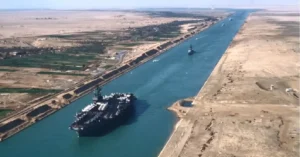Prelims Bits

Context
The ongoing tensions between Iran and Israel have raised concerns about rising oil prices and further disruptions to global trade. A key point of vulnerability is the Suez Canal.
Overview of the Suez Canal
- The Suez Canal is a man-made waterway, stretching 193 km, linking the Red Sea with the Mediterranean Sea via the Isthmus of Suez in Egypt.
- Construction took over 10 years, and it was formally opened on November 17, 1869.
- It is among the most critical maritime corridors globally, facilitating direct navigation between the Mediterranean Sea and the Indian Ocean.
- The Panama Canal is another globally important maritime route, connecting the Atlantic and Pacific Oceans.
Why the Suez Canal Is Crucial
- Geostrategic Route:
Serves as a vital transit point for shipping between Europe and Asia by connecting the Mediterranean with the Red Sea. - Reduces Transit Time and Distance:
Eliminates the need for ships to sail around the Cape of Good Hope, thereby cutting travel distance by approximately 7,000 km, saving both time and fuel. - Global Trade Lifeline:
According to the IMF, about 12–15% of global trade passes through the canal. It is also vital for the movement of 8–9% of global energy supplies. - Importance for India:
Nearly 80% of India’s exports to Europe use this route, making it essential for India’s foreign trade, particularly through the Red Sea corridor.
Challenges and Risks Associated with the Suez Canal
- Traffic Congestion:
Despite recent expansions, the canal (about 205 metres wide and 24 metres deep) often experiences heavy traffic and shipping delays.
Example: In March 2021, the container ship Ever Given ran aground, blocking the canal for several days and halting global trade flows. - Geopolitical Flashpoint:
The canal has been at the centre of historical conflicts, including the 1967 and 1973 Arab-Israeli wars, during which it remained closed for eight years (1967–1975). - Rising Trade Costs:
Due to regional instability in the Red Sea, rerouting cargo ships around Africa significantly increases shipping time and freight costs. - Security Risks:
Maritime piracy, drone attacks, and regional conflicts pose increasing threats to commercial vessels passing through this vital channel.
Other Strategic Maritime Routes
Strait of Hormuz
- Geography:
Located between Iran and Oman, at the entrance of the Persian Gulf. It links the Gulf to the Gulf of Oman and onward to the Arabian Sea.
- Dimensions:
At its narrowest, the strait is 33 km wide, with shipping lanes only 3 km wide in each direction. - Global Energy Artery:
Around 20% of globally traded oil and nearly all of Qatar’s LNG exports pass through this narrow strait, making it one of the world’s most sensitive energy chokepoints.
Panama Canal
- Opened in 1914, the Panama Canal connects the Atlantic Ocean to the Pacific Ocean across the Isthmus of Panama.
- Reduces voyage distance for ships traveling between U.S. East and West Coasts by nearly 8,000 nautical miles, avoiding the treacherous journey around Cape Horn at the tip of South America.




